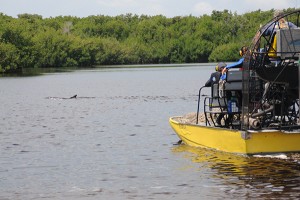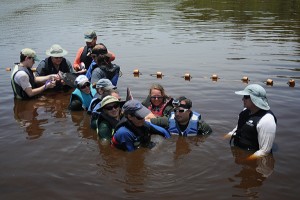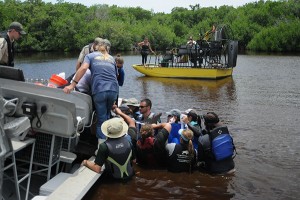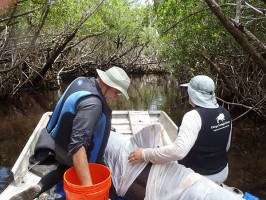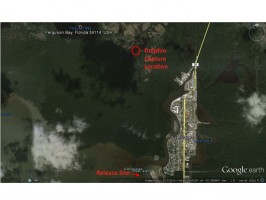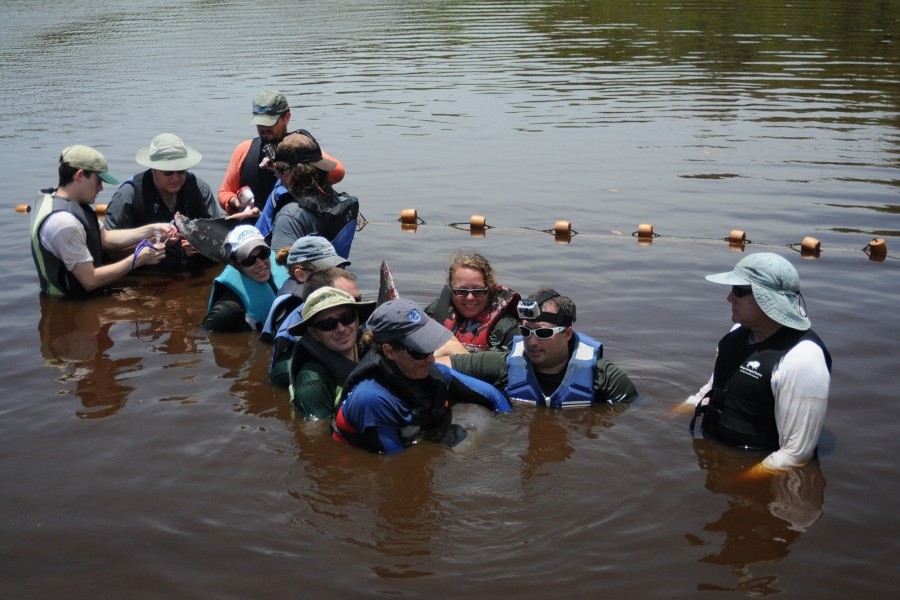Lake-Bound Dolphin Rescued Near Everglades City
An adult male dolphin that was caught in a small lake northwest of Everglades City in Collier County was rescued by about 20 members of the Southeast Region Marine Mammal Stranding Network on Thursday.
The 8.5-foot dolphin was first spotted swimming in a place he didn’t belong by staff of Speedy’s Airboat Tours, who called FWC to report the out-of-habitat animal. On Tuesday, Speedy’s took Denise Boyd, Research Associate with the Florida Fish and Wildlife Conservation Commission (FWC), to see the dolphin.
“After navigating through miles of narrow, shallow water canals and grass flats by airboat to reach the dolphin, we knew it was unable to leave the area on its own accord and would need to be rescued,” Boyd said. “Based on the dolphin’s size and location, a small team alone could not do the rescue. Therefore, we reached out to the many partners in the area to assist with the relocation effort.”
After assessing the animal’s condition and providing the information to the National Marine Fisheries Service of NOAA — the agency that oversees the management of marine mammals under the Marine Mammal Protection Act — Boyd was given permission to scramble the Southeast Region Marine Mammal Stranding Network to mount a rescue.
Five agencies answered Boyd’s urgent call for help. In addition to FWC, Mote Marine Laboratory’s Stranding Investigation Program, the Sarasota Dolphin Research Program/Chicago Zoological Society, Disney’s Animal Science and Environment, Rookery Bay National Estuarine Research Reserve and Big Cypress National Preserve sent about 25 people to try to rescue the dolphin. Speedy’s Airboat Tours also provided three airboats and the critical local knowledge needed to navigate very shallow waters through myriad mangrove tunnels to get the team to the animal. FWC Law Enforcement provided officers and a large airboat to transport the dolphin to the bay.
Without intervention, the animal likely would have died, said Gretchen Lovewell, manager of Mote’s Stranding Investigations Program. “We think the dolphin swam into this area on a very high tide,” Lovewell said. “After the tide went out again and without much rain in the area, there was no way the dolphin would have been able to get back to Chokoloskee Bay. The water was so shallow that the dolphin spent a lot of time swimming on his side, and the tips of his flukes had signs of scrapes and abrasions from hitting the bottom.”
The team assembled in Everglades City Thursday morning and left at about 11 a.m. The dolphin was released at 2:50 p.m.
Dr. Randy Wells, Director of the Sarasota Dolphin Research Program (a partnership between Mote and the Chicago Zoological Society), said this was one the of the most challenging rescues he’s ever been involved in during his 44 years of conducting dolphin research and rescues.
“There was an 8-foot alligator in the net enclosure we created to capture the dolphin,” Wells said. “We were working in ankle to knee-deep mud. And there were many miles of shallow, twisting, narrow mangrove tunnels to navigate in order to get the dolphin back to the bay so it would have a chance to survive. Fortunately, after we got to the bay, the dolphin swam away in good condition.”
Before it was released, the animal was outfitted with a satellite-linked tag so Dr. Wells can monitor the dolphin’s progress. “Being able to follow the animal after release helps us to know whether a rescue has been successful and guides possible future rescues.”
The dolphin was nicknamed “Speedy” to thank Speedy’s Airboat Tours for finding the dolphin and for playing such a critical role in the animal’s recovery. “Things went amazingly well considering all the challenges,” Lovewell said. “Without Speedy’s airboats and experienced captains, we could never have mounted this rescue.”
You Can Help
Rescuing stranded marine mammals takes a group effort — from members of the public who report sick or injured animals and the management agencies that authorize such rescues to take place to the “boots-on-the-ground” teams at nonprofit institutions and organizations that conduct many such rescues. Nonprofit organizations rely on public donations to fund such work. Please consider making a donation to Mote Marine Laboratory or another participating agency to help. Online at mote.org/support.
